inflation pressure DODGE CHALLENGER SRT 2019 Vehicle Warranty
[x] Cancel search | Manufacturer: DODGE, Model Year: 2019, Model line: CHALLENGER SRT, Model: DODGE CHALLENGER SRT 2019Pages: 270, PDF Size: 2.52 MB
Page 43 of 270
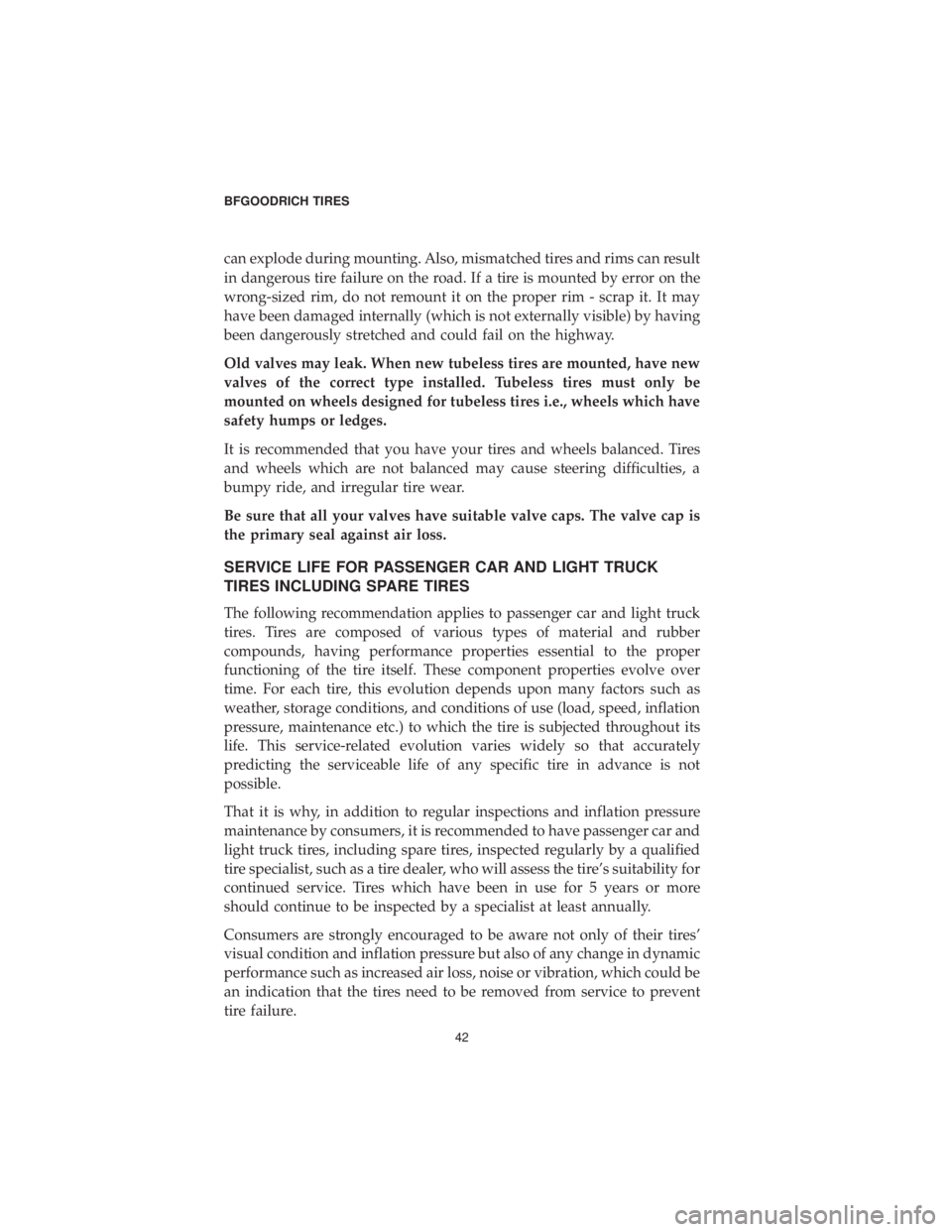
can explode during mounting. Also, mismatched tires and rims can result
in dangerous tire failure on the road. If a tire is mounted by error on the
wrong-sized rim, do not remount it on the proper rim - scrap it. It may
have been damaged internally (which is not externally visible) by having
been dangerously stretched and could fail on the highway.
Old valves may leak. When new tubeless tires are mounted, have new
valves of the correct type installed. Tubeless tires must only be
mounted on wheels designed for tubeless tires i.e., wheels which have
safety humps or ledges.
It is recommended that you have your tires and wheels balanced. Tires
and wheels which are not balanced may cause steering difficulties, a
bumpy ride, and irregular tire wear.
Be sure that all your valves have suitable valve caps. The valve cap is
the primary seal against air loss.
SERVICE LIFE FOR PASSENGER CAR AND LIGHT TRUCK
TIRES INCLUDING SPARE TIRES
The following recommendation applies to passenger car and light truck
tires. Tires are composed of various types of material and rubber
compounds, having performance properties essential to the proper
functioning of the tire itself. These component properties evolve over
time. For each tire, this evolution depends upon many factors such as
weather, storage conditions, and conditions of use (load, speed, inflation
pressure, maintenance etc.) to which the tire is subjected throughout its
life. This service-related evolution varies widely so that accurately
predicting the serviceable life of any specific tire in advance is not
possible.
That it is why, in addition to regular inspections and inflation pressure
maintenance by consumers, it is recommended to have passenger car and
light truck tires, including spare tires, inspected regularly by a qualified
tire specialist, such as a tire dealer, who will assess the tire’s suitability for
continued service. Tires which have been in use for 5 years or more
should continue to be inspected by a specialist at least annually.
Consumers are strongly encouraged to be aware not only of their tires’
visual condition and inflation pressure but also of any change in dynamic
performance such as increased air loss, noise or vibration, which could be
an indication that the tires need to be removed from service to prevent
tire failure.
BFGOODRICH TIRES42
Page 45 of 270
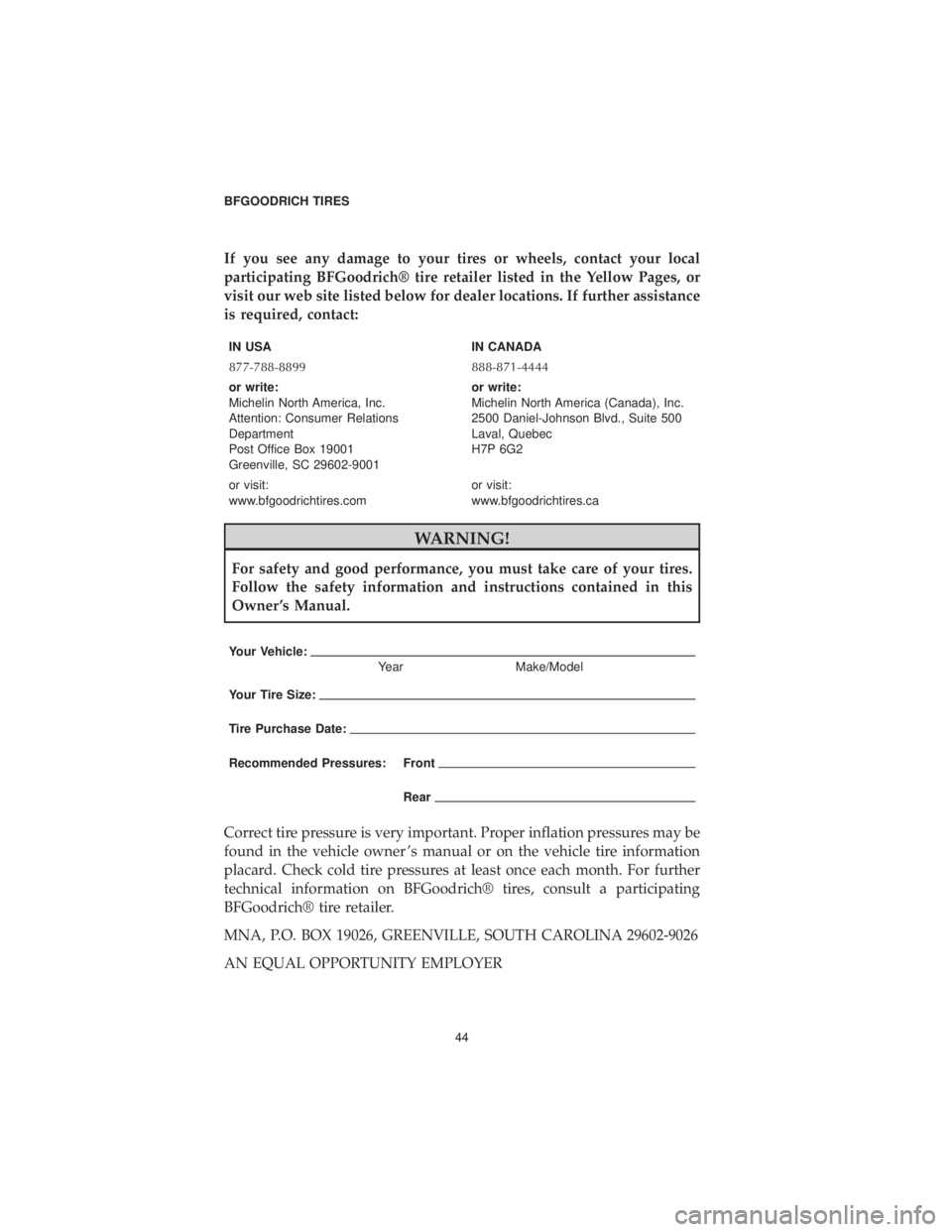
If you see any damage to your tires or wheels, contact your local
participating BFGoodrich® tire retailer listed in the Yellow Pages, or
visit our web site listed below for dealer locations. If further assistance
is required, contact:
IN USAIN CANADA
877-788-8899 888-871-4444
or write:
Michelin North America, Inc.
Attention: Consumer Relations
Department
Post Office Box 19001
Greenville, SC 29602-9001 or write:
Michelin North America (Canada), Inc.
2500 Daniel-Johnson Blvd., Suite 500
Laval, Quebec
H7P 6G2
or visit:
www.bfgoodrichtires.com or visit:
www.bfgoodrichtires.ca
WARNING!
For safety and good performance, you must take care of your tires.
Follow the safety information and instructions contained in this
Owner ’s Manual.
Your Vehicle:Year
Make/Model
Your Tire Size:
Tire Purchase Date:
Recommended Pressures: Front
Rear
Correct tire pressure is very important. Proper inflation pressures may be
found in the vehicle owner ’s manual or on the vehicle tire information
placard. Check cold tire pressures at least once each month. For further
technical information on BFGoodrich® tires, consult a participating
BFGoodrich® tire retailer.
MNA, P.O. BOX 19026, GREENVILLE, SOUTH CAROLINA 29602-9026
AN EQUAL OPPORTUNITY EMPLOYER
BFGOODRICH TIRES
44
Page 47 of 270
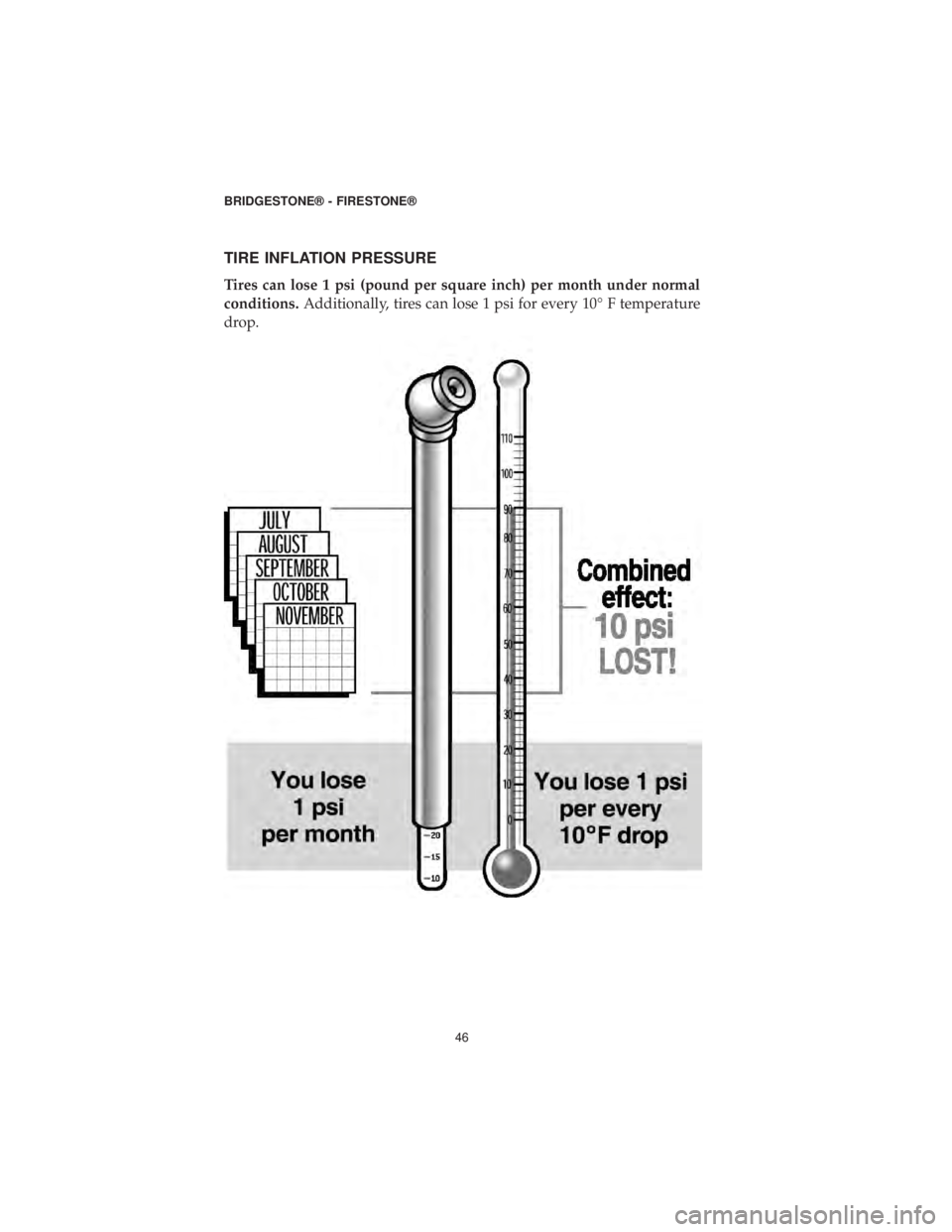
TIRE INFLATION PRESSURE
Tires can lose 1 psi (pound per square inch) per month under normal
conditions.Additionally, tires can lose 1 psi for every 10° F temperature
drop.
BRIDGESTONE® - FIRESTONE®
46
Page 49 of 270
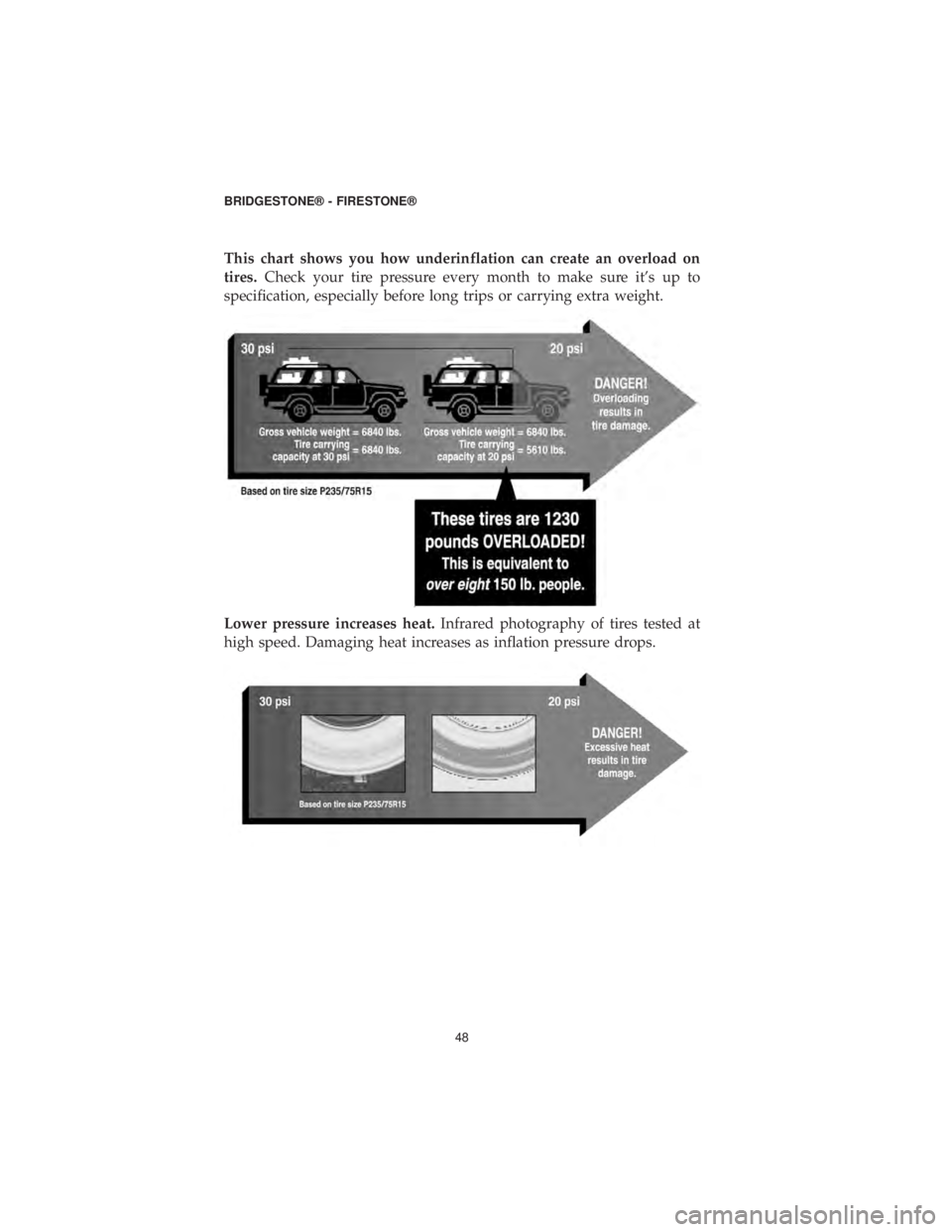
This chart shows you how underinflation can create an overload on
tires.Check your tire pressure every month to make sure it’s up to
specification, especially before long trips or carrying extra weight.
Lower pressure increases heat. Infrared photography of tires tested at
high speed. Damaging heat increases as inflation pressure drops.
BRIDGESTONE® - FIRESTONE®
48
Page 50 of 270
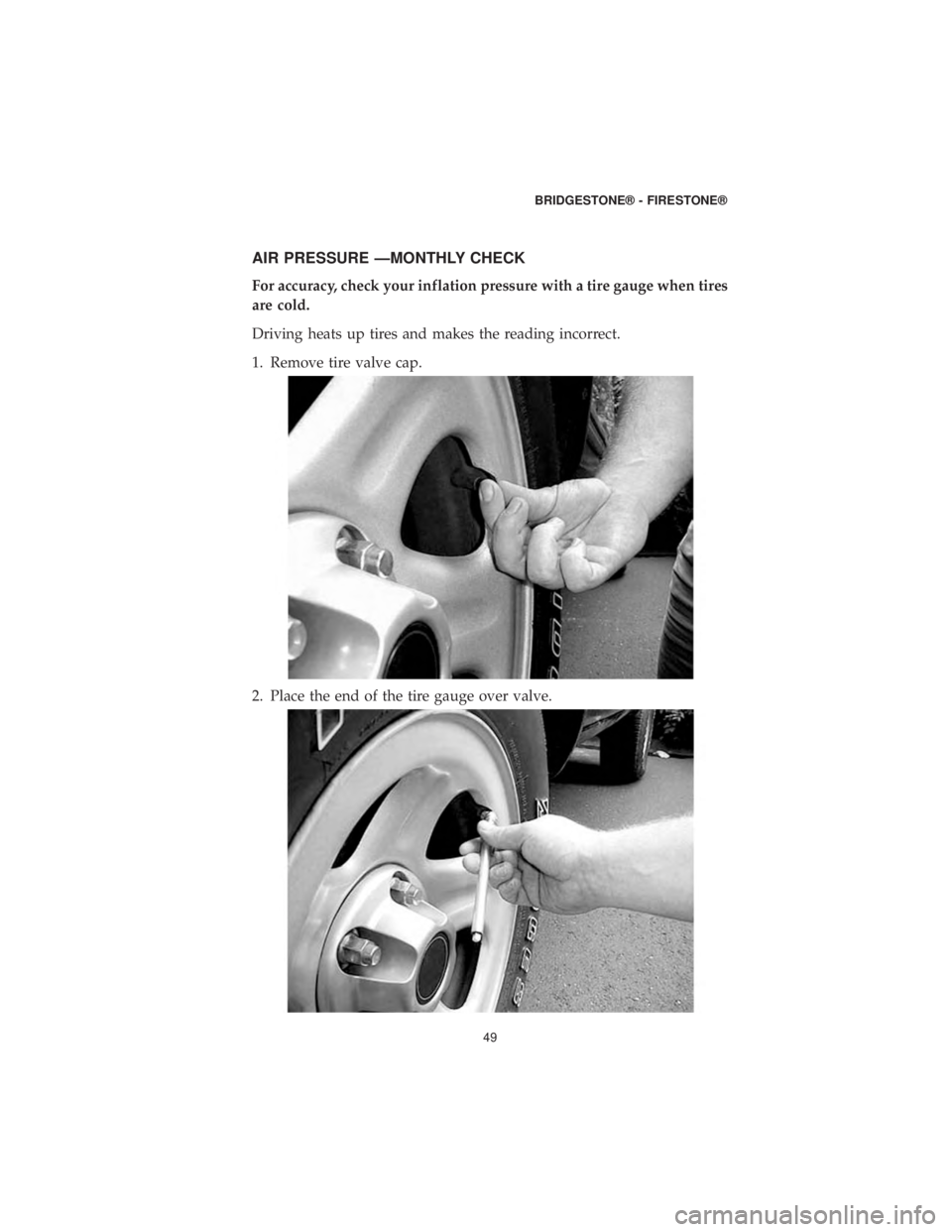
AIR PRESSURE —MONTHLY CHECK
For accuracy, check your inflation pressure with a tire gauge when tires
are cold.
Driving heats up tires and makes the reading incorrect.
1. Remove tire valve cap.
2. Place the end of the tire gauge over valve.
BRIDGESTONE® - FIRESTONE®
49
Page 54 of 270
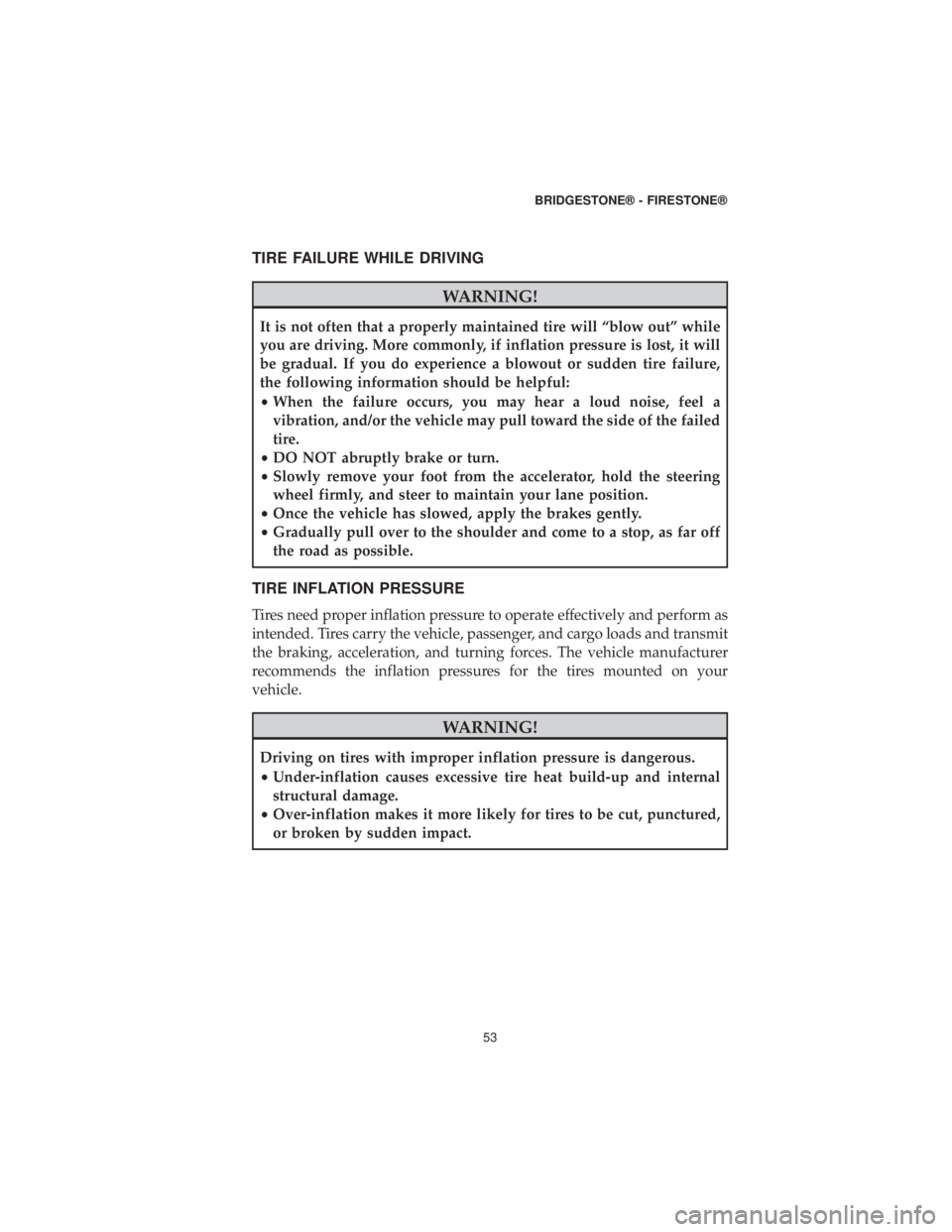
TIRE FAILURE WHILE DRIVING
WARNING!
It is not often that a properly maintained tire will “blow out” while
you are driving. More commonly, if inflation pressure is lost, it will
be gradual. If you do experience a blowout or sudden tire failure,
the following information should be helpful:
•When the failure occurs, you may hear a loud noise, feel a
vibration, and/or the vehicle may pull toward the side of the failed
tire.
• DO NOT abruptly brake or turn.
• Slowly remove your foot from the accelerator, hold the steering
wheel firmly, and steer to maintain your lane position.
• Once the vehicle has slowed, apply the brakes gently.
• Gradually pull over to the shoulder and come to a stop, as far off
the road as possible.
TIRE INFLATION PRESSURE
Tires need proper inflation pressure to operate effectively and perform as
intended. Tires carry the vehicle, passenger, and cargo loads and transmit
the braking, acceleration, and turning forces. The vehicle manufacturer
recommends the inflation pressures for the tires mounted on your
vehicle.
WARNING!
Driving on tires with improper inflation pressure is dangerous.
• Under-inflation causes excessive tire heat build-up and internal
structural damage.
• Over-inflation makes it more likely for tires to be cut, punctured,
or broken by sudden impact.
BRIDGESTONE® - FIRESTONE®
53
Page 55 of 270
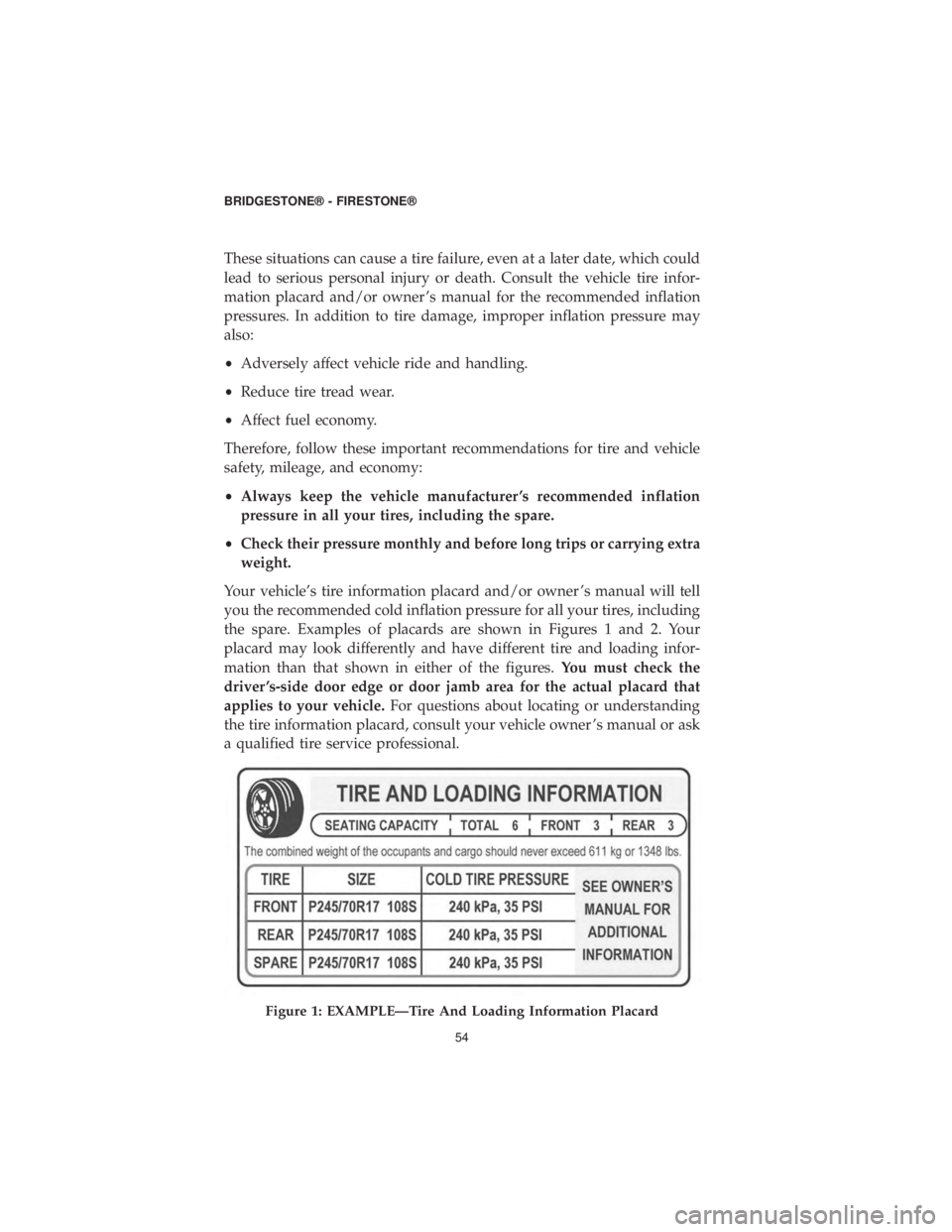
These situations can cause a tire failure, even at a later date, which could
lead to serious personal injury or death. Consult the vehicle tire infor-
mation placard and/or owner ’s manual for the recommended inflation
pressures. In addition to tire damage, improper inflation pressure may
also:
•Adversely affect vehicle ride and handling.
• Reduce tire tread wear.
• Affect fuel economy.
Therefore, follow these important recommendations for tire and vehicle
safety, mileage, and economy:
• Always keep the vehicle manufacturer ’s recommended inflation
pressure in all your tires, including the spare.
• Check their pressure monthly and before long trips or carrying extra
weight.
Your vehicle’s tire information placard and/or owner ’s manual will tell
you the recommended cold inflation pressure for all your tires, including
the spare. Examples of placards are shown in Figures 1 and 2. Your
placard may look differently and have different tire and loading infor-
mation than that shown in either of the figures. You must check the
driver ’s-side door edge or door jamb area for the actual placard that
applies to your vehicle. For questions about locating or understanding
the tire information placard, consult your vehicle owner ’s manual or ask
a qualified tire service professional.
Figure 1: EXAMPLE—Tire And Loading Information Placard
BRIDGESTONE® - FIRESTONE®
54
Page 56 of 270
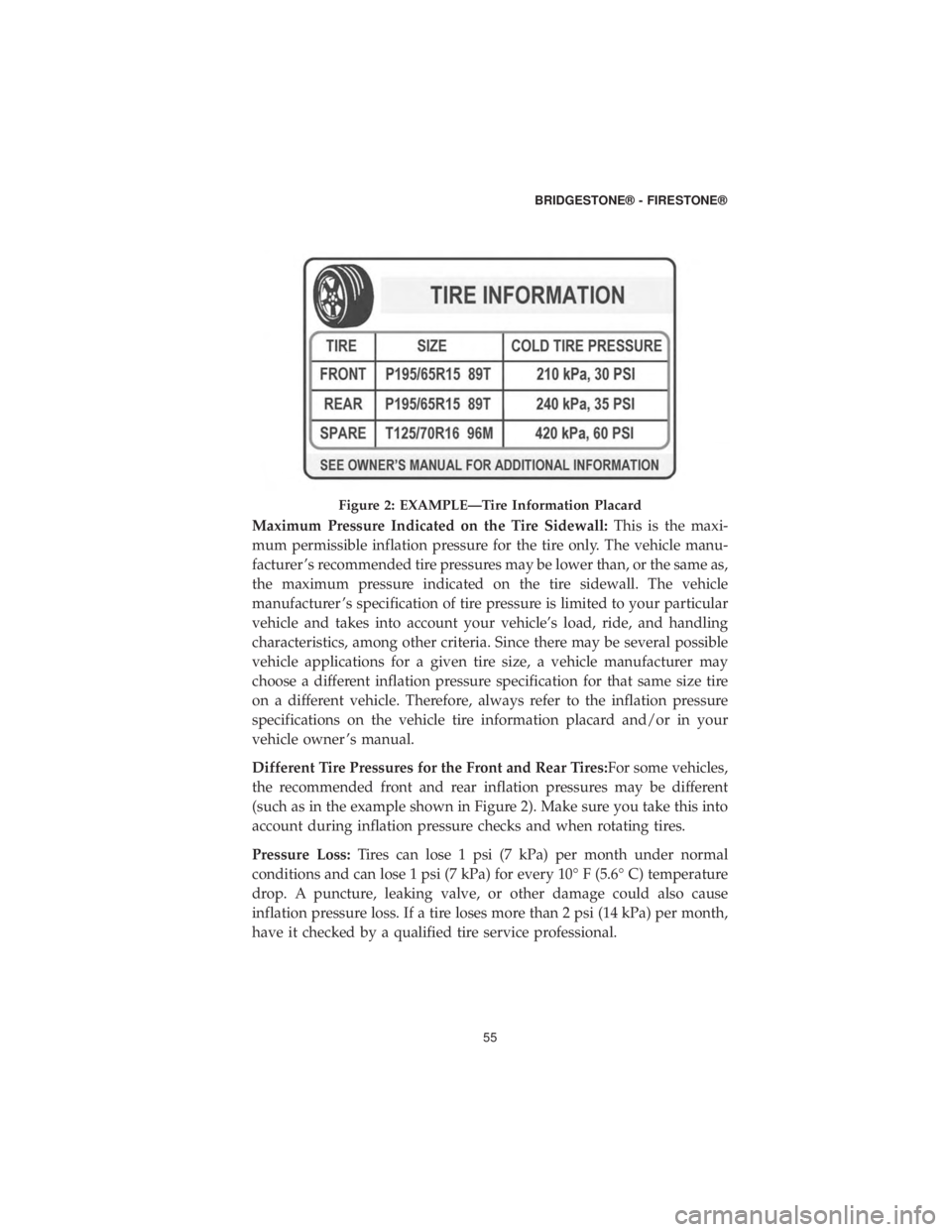
Maximum Pressure Indicated on the Tire Sidewall:This is the maxi-
mum permissible inflation pressure for the tire only. The vehicle manu-
facturer ’s recommended tire pressures may be lower than, or the same as,
the maximum pressure indicated on the tire sidewall. The vehicle
manufacturer ’s specification of tire pressure is limited to your particular
vehicle and takes into account your vehicle’s load, ride, and handling
characteristics, among other criteria. Since there may be several possible
vehicle applications for a given tire size, a vehicle manufacturer may
choose a different inflation pressure specification for that same size tire
on a different vehicle. Therefore, always refer to the inflation pressure
specifications on the vehicle tire information placard and/or in your
vehicle owner ’s manual.
Different Tire Pressures for the Front and Rear Tires:For some vehicles,
the recommended front and rear inflation pressures may be different
(such as in the example shown in Figure 2). Make sure you take this into
account during inflation pressure checks and when rotating tires.
Pressure Loss: Tires can lose 1 psi (7 kPa) per month under normal
conditions and can lose 1 psi (7 kPa) for every 10° F (5.6° C) temperature
drop. A puncture, leaking valve, or other damage could also cause
inflation pressure loss. If a tire loses more than 2 psi (14 kPa) per month,
have it checked by a qualified tire service professional.
Figure 2: EXAMPLE—Tire Information Placard
BRIDGESTONE® - FIRESTONE®
55
Page 57 of 270
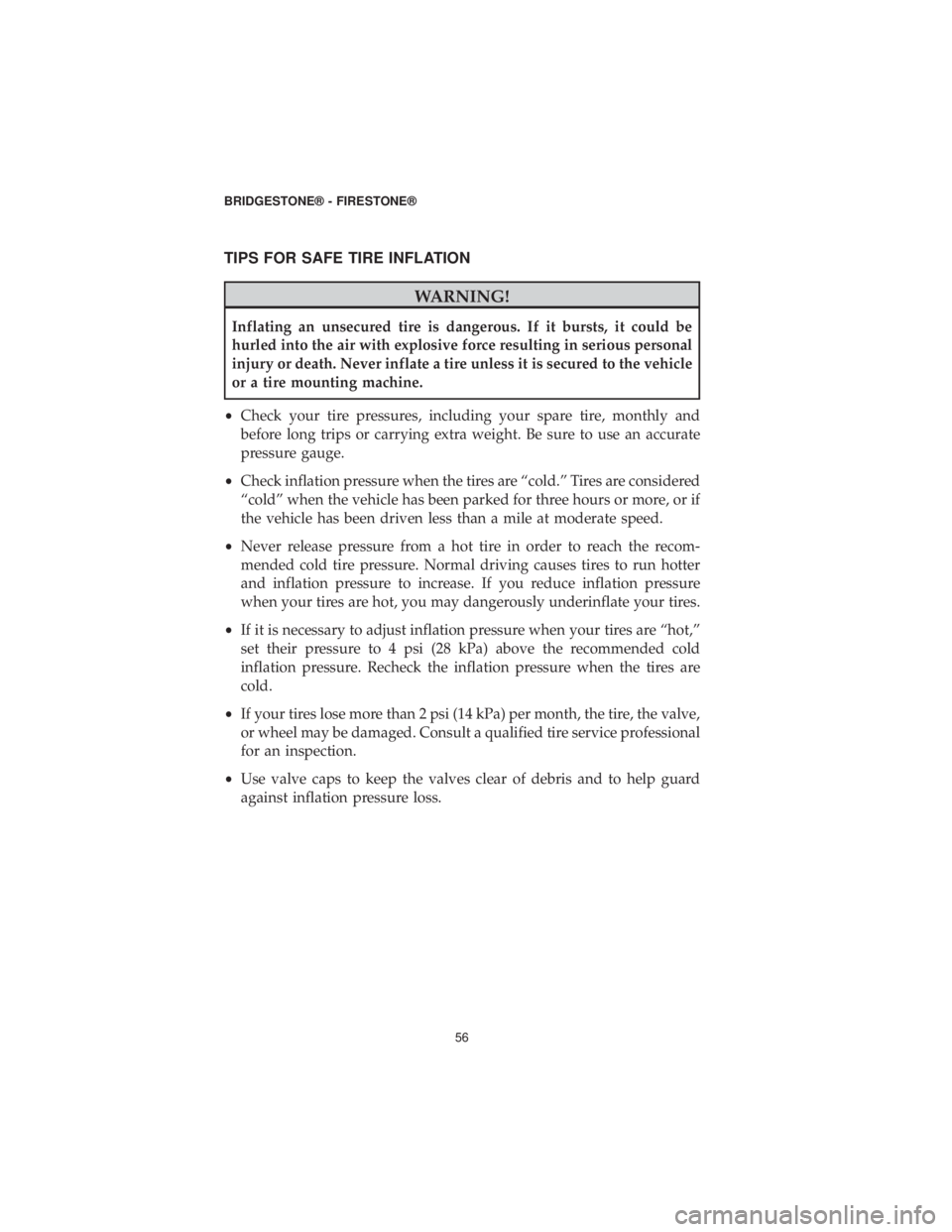
TIPS FOR SAFE TIRE INFLATION
WARNING!
Inflating an unsecured tire is dangerous. If it bursts, it could be
hurled into the air with explosive force resulting in serious personal
injury or death. Never inflate a tire unless it is secured to the vehicle
or a tire mounting machine.
• Check your tire pressures, including your spare tire, monthly and
before long trips or carrying extra weight. Be sure to use an accurate
pressure gauge.
• Check inflation pressure when the tires are “cold.” Tires are considered
“cold” when the vehicle has been parked for three hours or more, or if
the vehicle has been driven less than a mile at moderate speed.
• Never release pressure from a hot tire in order to reach the recom-
mended cold tire pressure. Normal driving causes tires to run hotter
and inflation pressure to increase. If you reduce inflation pressure
when your tires are hot, you may dangerously underinflate your tires.
• If it is necessary to adjust inflation pressure when your tires are “hot,”
set their pressure to 4 psi (28 kPa) above the recommended cold
inflation pressure. Recheck the inflation pressure when the tires are
cold.
• If your tires lose more than 2 psi (14 kPa) per month, the tire, the valve,
or wheel may be damaged. Consult a qualified tire service professional
for an inspection.
• Use valve caps to keep the valves clear of debris and to help guard
against inflation pressure loss.
BRIDGESTONE® - FIRESTONE®
56
Page 58 of 270
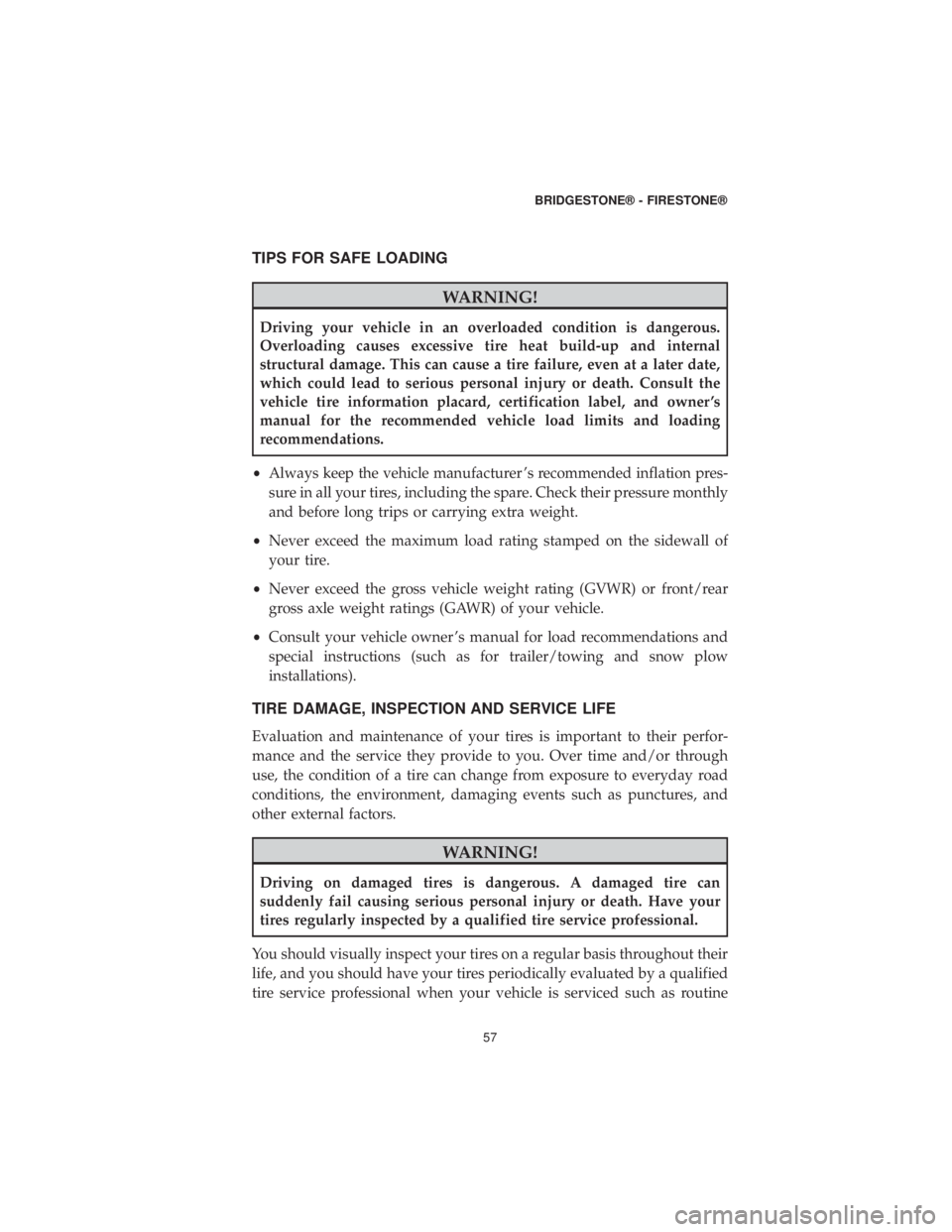
TIPS FOR SAFE LOADING
WARNING!
Driving your vehicle in an overloaded condition is dangerous.
Overloading causes excessive tire heat build-up and internal
structural damage. This can cause a tire failure, even at a later date,
which could lead to serious personal injury or death. Consult the
vehicle tire information placard, certification label, and owner ’s
manual for the recommended vehicle load limits and loading
recommendations.
• Always keep the vehicle manufacturer ’s recommended inflation pres-
sure in all your tires, including the spare. Check their pressure monthly
and before long trips or carrying extra weight.
• Never exceed the maximum load rating stamped on the sidewall of
your tire.
• Never exceed the gross vehicle weight rating (GVWR) or front/rear
gross axle weight ratings (GAWR) of your vehicle.
• Consult your vehicle owner ’s manual for load recommendations and
special instructions (such as for trailer/towing and snow plow
installations).
TIRE DAMAGE, INSPECTION AND SERVICE LIFE
Evaluation and maintenance of your tires is important to their perfor-
mance and the service they provide to you. Over time and/or through
use, the condition of a tire can change from exposure to everyday road
conditions, the environment, damaging events such as punctures, and
other external factors.
WARNING!
Driving on damaged tires is dangerous. A damaged tire can
suddenly fail causing serious personal injury or death. Have your
tires regularly inspected by a qualified tire service professional.
You should visually inspect your tires on a regular basis throughout their
life, and you should have your tires periodically evaluated by a qualified
tire service professional when your vehicle is serviced such as routine
BRIDGESTONE® - FIRESTONE®
57